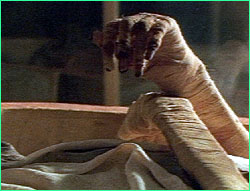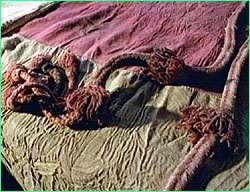
|
 |
 |
by Jan Adkins Mummies—named after the bitumen tar, mum, used to coat the linen winding strips around them—have long held an almost magical fascination. The "civilized" world was titillated by Egypt's elaborate cult of death and by the extreme care devoted to preserving bodies for eternity. It was not uncommon in the 1800s to pick up a box of "mummy pills" made of ground, compressed mummies; they were thought to impart some measure of the eternal. In proper Boston the mummy of a pharaoh's son stood on the bar of a venerable men's club until the late 1960s, when he was returned to his homeland. We have come to understand "mummy" as meaning a remarkably preserved body, a corpse that has withstood decay and putrefaction. (See Mummies of the World) By design or accident, the corpse's dissolution has been arrested, the effects of time slowed, and this human form, with its trappings and ornaments and clothing, becomes the physical representation of another time. A time machine bearing both gifts of knowledge, and prickly questions as to how best to handle the remains.
The Siberian Ice Maiden, a well-preserved mummy unearthed on the steppes of eastern Russia in 1993, was a spectacular discovery. She was dressed in glorious finery—fine-woven wool skirt, wild-silk blouse, an elaborate high-status headpiece, and jewelry of wonderful craftsmanship. Interred with household items and familiar treasures, she was laid to rest with respect and reverence. Her finely wrought coffin, sealed with massive metal nails, was accompanied by six horses, ensuring her status and freedom of movement in the next world. The finds suggest that the society of tribal horse nomads she left behind must have been stable and wealthy.
Continue: Knowledge at a Price Peru Expedition '96 | Unquiet Mummies | Iceman's Last Meal Reading the Remains | Resources | Teacher's Guide Transcripts | Site Map | Ice Mummies Home Editor's Picks | Previous Sites | Join Us/E-mail | TV/Web Schedule About NOVA | Teachers | Site Map | Shop | Jobs | Search | To print PBS Online | NOVA Online | WGBH © | Updated November 2000 |
 Wrapped hands of an Egyptian mummy
Wrapped hands of an Egyptian mummy
 Clothing of the Ice Maiden
Clothing of the Ice Maiden
 The Ice Maiden in her tomb.
The Ice Maiden in her tomb.